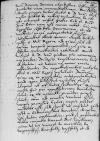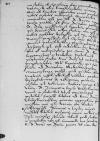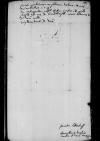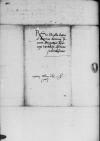Quod sibi odiosa quaeque tribui scribit Reverendissima Dominatio Vestra et se nescio quibus de rebus insimulari, de iis ego comperti nihil habeo. Sed et ⌊reverendissimus dominus⌋ bono eam esse animo iubet. Cui cum legissem schedam Germanicam et ad verbum prope interpretatus fuissem, satisfaciebat illius animo. Neque dubito, quin serenissimae ⌊maiestati regiae⌋, ad quam sub id ipsum tempus properabat, ea, quae in scheda continebantur, retulerit. Quod voluit Reverendissima Dominatio Vestra quadam cum acrimonia responderi ⌊dominorum consiliariorum⌋ litteris, id factum, ac vereor, ne animi eorum offendantur. De appellationibus molesta fuit serenissimae ⌊maiestatis regiae⌋ postulatio ⌊dominorum⌋, quam ex eo profectam interpretabatur, quod aegre tulissent, rescissas fuisse aliquot ab eis latas sententias. ⌊Quorum⌋ causae huc per appellationem devolutae sunt, ex iis nonnulli graviter questi sunt: cum ad comitia ventum esset, neque processus lectos, neque partes auditas esse, sed simul, ut constitit, quid esset a Gedanensibus decretum, id ipsum esse statim confirmatum; quod se gravioribus rebus occupatos dicerent ⌊domini consiliarii⌋, quam ut eis vacaret de cineribus, de wagenschosz, knarrholtz, vaszholtz et id genus aliis cognoscere. Mihi mandatur provincia processus legendi, plena certe laboris et molestiae. Refero ea, quae legi ⌊reverendissimo domino⌋. Et certe ita mihi videtur adhuc iudicatum, ut nulli facta sit iniuria.
Duae controversiae rescissae sunt proxima aestate, quae tres habebant conformes, sed magn[a] certa ratione. De cineribus una inter Ioannem Kun appellantem et Winoldum Funf. Habuit hic tres conformes pro se: sed quae nitebantur unius tantum homin[is], et eius Rutheni iniurati, testimonio, qui alio in iudicio iuratus fefellerat. Et tamen hoc ipso testimonio non plus qua[m] quinquaginta quattuor lasti dicebantur accepti, et centum ut solveret reus fui[t] pronuntiatum. Interrogatus fuit a me Winoldus, ubi esset vel minima nota in processu eius rei, quod centum deberentur; datus est ei processus, ut quaereret atqu[e] altero die ostenderet; nihil ostendit. Qui[d] hic aliud facere oportebat serenissimam ⌊maiestatem regiam⌋ cognita causa, quam quod fecit?
Altera fuit controversia inter Ioannem Heidebrec[her] et Martinum Hermensdorf. Habuit ille tres conformes decretumque fuit, ut reus dominium probaret, cum actori incumbat probatio, ei praesertim, qui agit rei vindicatione, et in re dubia semper sit melior condicio possidentis. Si itaque, quod ius postulabat, hoc decretum est, non esse videtur id acerbius ferendum. Sed de his non est meum fortasse scribere, nisi quod ⌊reverendissimus dominus⌋ iussit, ut quamobrem bis tres conformes rescissae sint, Reverendissimae Dominstioni Vestrae perscriberem. Est hic animadversum, praeter unam causam domini ⌊Ioannis Holstein⌋, esse in aliis fere semper decreta Gedanensium confirmata. Unde suspicio orta est non temere vociferari nonnullos, processus in iudicio non legi, sed res tantum iudicatas attendi. Haec ego pro meo erga Reverendissimam Dominationem Vestram studio et observantia celare illam nolui. Dominus ⌊Ioannes Holstein⌋ quantum adhuc cognoscere licuit, iustam causam habere mihi videtur. Cui affuturus sum libenter, quantum potero. Quod postulavit mandatum Reverendissima Dominatio Vestra, id ei mittitur.
Plaustra rerum novarum mitto Reverendissimae Dominationi Vestrae. Exspectatur in horas domini ⌊castellani Posnaniensis⌋ adventus et is afferet fortasse aliquid. Horrenda haec nova initio perturbaverant animos nostros, sed in venatione fuerunt, ut audio, satis hilares, ne nunc quidem ullum est animi perturbati signum. Pedem hinc moturi non videmur neque ad comitia profecturi. Adeo arridet nonnullis in hac terra commoratio, ut sint, qui etiam aestatem insequentem hic nos posituros affirment. ⌊Sapia⌋ manet in arce superiori et manebit fortasse multorum opinione diutius. Est in eo castello sacellum divi Martini, cuius ego sum praebendarius. Edictum mihi est, ne statum ibi sacrificium fieri permitterem, verum id alio transferendum curarem. Qui ad limites regundos erant profecti, rebus infectis redierunt. Queruntur occupatam esse per illustrissimum dominum ⌊ducem⌋ magn[am] terrae partem ad hunc ducatum pertinen[tem]. Dominus ⌊dux⌋ missurum se legatum promittit, qui doceat sua culpa factum non esse, qu[od] rebus infectis discessum est.
In ⌊castro Barensi⌋ praesidium est ⌊caesaris⌋. Quod no[n] ignorat procul dubio, proscriptionis cau[sa] suspensa est. Sed inductum iri decretu[m] hoc et antiquatum, per serenissimum dominum ⌊Romanorum regem⌋ spes ostenditur. Postulavit praeterea ⌊frater⌋ ⌊reverendissimi domini⌋, ut certus dies praefiniretur ⌊maiestati reginali⌋, quo ius suum ad ⌊ducatum Mediolanensem⌋ commonstrare posset. Quod quidem obtinu[it].
Praeterea nihil attulisse videtur, praeter disceptationes de religione, quarum iustum est volumen. Habere, opinor Reverendissimam Dominationem Vestram, dominus ⌊Ioannes a Lasco⌋ ⌊Vratislaviam⌋ venit: a fratribus, ut se convenirent, postulat. Scripsit litteras ad reverendissimum ⌊dominum Vladislaviensem⌋; quarum exemplum huc missum non est, verum ita dicitur subscripsisse: “⌊Ioannes a Lasco⌋, nuper multis titulis insignis, nunc nudus nu[di] Iesu crucifixi servus”. Aliud quod scribam in praesentia non est.
Commendo me gratiae Reverendissimae Dominationis Vestrae ac Deum precor, ut eam diu servet incolumem ac felicem.





